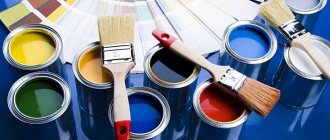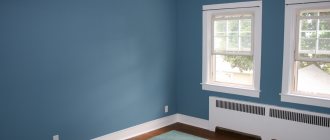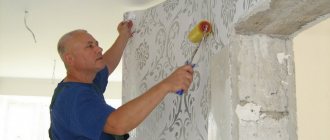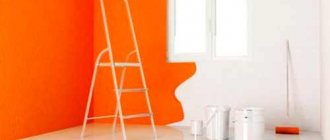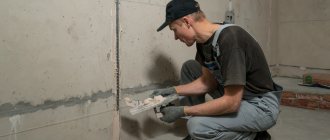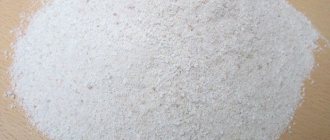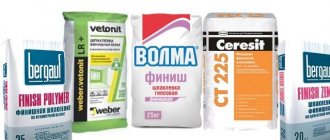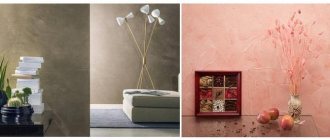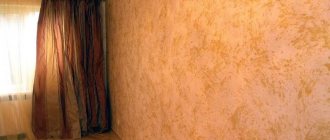| Place | Name | Characteristics in the rating |
| The best acrylic water-based paint |
| 1 | Sniezka Eko (10 l) | Hypoallergenic composition |
| 2 | Alpina Renova (10 l) | The optimum ratio of price and quality |
| 3 | PARADE W4 (9 l) | Durable coating |
| 4 | Farbitex Profi (14 kg) | Low price. Economical consumption from 90 g/m2 |
| The best silicate water-based paint |
| 1 | TIKKURILA Finngard SILIKAATTIMAALI (18l) | Best heat resistance range |
| 2 | Ceresit ST 54 (15 kg) | High quality. Does not deteriorate from moisture and sunlight |
| 3 | Dulux Bindo Flame retardant matte (9 l) | For premises with increased fire safety requirements |
| 4 | PUFAS Fassaden-Silikat (10 l) | Low consumption |
| The best silicone water-based paint |
| 1 | Ceresit CT 48 (15 l) | Favorable price-quality ratio |
| 2 | Tikkurila Novasil (2.7 l) | Will last 20 years |
| 3 | Alpina Expert (15 kg) | Not afraid of environmental influences |
| 4 | Caparol CapaSilan (2.5 kg) | Forms a perfectly smooth coating without streaks or joints |
Interior decoration is one of the most important stages of renovation. To do a brilliant job, you will need not only skill, but also high-quality materials. For painting walls and ceilings, you can find a huge selection of water-based paints: acrylic, silicate, silicone, etc. Despite the fact that they differ in their properties and quality, they are all popular among both professionals and amateurs. The secret is simple - they are very convenient to use. Even if you don’t have much experience working with paints, with such materials you can easily eliminate wall defects and turn the room into a cozy and beautiful space.
The best manufacturers of paints for walls and ceilings
Tikkurila
is a Finnish manufacturer of paints and varnishes that has taken a leading position in the market. For more than 150 years it has been producing high-quality and environmentally friendly compounds for any purpose and surface.
Alpina
is a German brand whose products are famous not only for quality, but also for ease of use. The paints adhere perfectly to any substrate, do not form streaks and perfectly cover the base.
Dulux
is a Russian company whose products are not inferior in quality to European ones. The compositions have everything you need: optimal consistency, excellent color palette, environmental friendliness, wear resistance.
CERESIT
is a German brand that has become number 1 in Russia. The company produces not only paintwork materials, but also other materials for repairs with an excellent price-quality ratio.
Sniezka
is one of the leading manufacturers of paints and varnishes in Poland and Europe. The products are famous for their quality, durability and affordable prices.
Basic information
Dispersion paints are a type of paint and varnish products made using synthetic resins and petroleum products. Elements contained in the composition such as pigments, fillers, film formers, as well as various special-purpose additives give the painted surface durability, water resistance and fire safety.
In addition, the advantages of this coating include ease of application, quick drying and vapor permeability (the so-called “breathable effect”). The detailed characteristics of dispersion paints differ depending on the composition and scope of application.
Manufacturers' catalogs present numerous photos of dispersion paints and the results of painted objects. However, to achieve this you need to understand what to choose for a specific solution.
How to choose paint for walls and ceilings
There are no universal compositions, so each room requires its own type of coating. When choosing paint for walls and ceilings, experts advise paying attention to:
- Durability.
The coating should not crumble and quickly lose its attractive appearance. The minimum service life is at least 5 years. - Resistant to washing.
No matter how carefully you move around the house, the walls get dirty and need to be washed regularly. That is why we recommend taking a closer look at washable mixtures. - Environmentally friendly.
If you are planning to paint a living room, then pay attention to the composition - it should not contain aggressive solvents or other dangerous components. In addition, for interior work it is better to choose odorless, hypoallergenic options. - Waterproof and lightfast.
The indicators are especially relevant if you are choosing paint for finishing the kitchen or rooms located on the sunny side. - Economical.
Pay attention to the consumption in order to adequately calculate the required amount of paint - on average, one liter should be enough to treat at least 5-6 square meters. m.
The best water-based ceiling paint for interior work
Painting a ceiling is an easy and clean job (compared to, for example, whitewashing). You can handle it yourself, without the involvement of professional craftsmen.
Tikkurila Harmony
Tikkuril paint is based on a 100% acrylate binder; it is highly resistant to cleaning, despite its velvet effect. In addition to the ceiling area, the material can be used to process walls, as well as decorative elements made of concrete, wood, plaster, cardboard, and brick. Not recommended for use when painting doors and furniture.
Tikkurila Harmony
Material consumption depends on the type of base:
- when applied to a non-absorbent surface – 10-12 m2/l;
- when applied to absorbent substrates – 7-9 m2/l.
The material is packaged in containers of 0.9 l, 2.7 and 9 l. Water may be used as a solvent. Apply using a brush, roller or spray.
Profilux PL-10L
Matte white paint is suitable for use in kitchens and bathrooms with high humidity. Available in a closed container weighing 6 kg. The composition is based on latex, after purchase it is immediately ready for use.
Profilux PL-10L
The material is odorless and has increased resistance to moisture and fumes. Used for painting walls and ceilings. When painting surfaces in multiple layers, it is necessary to maintain a time interval of 2 hours, but the product requires 24 hours to dry completely. A 2.5 liter product costs 350 rubles.
Types of dispersion paints
The key to a well-painted surface will be the preparation of the base and the correct choice of materials. It is also necessary to determine several factors, such as the presence of dampness in the room and the effect of natural light on future painted surfaces. How to choose dispersion paint after careful preliminary preparation?
Pros and cons of water emulsion
Water-based paint for walls and other surfaces began to be actively used in the post-war period. Many plants and factories were destroyed. Other buildings were also destroyed. Restoration was required quickly and cheaply.
The emphasis was on materials that, roughly speaking, could be produced in a garage. Then this became an advantage of the water-based emulsion. Now, the ease of its production is partly a disadvantage, allowing the production of fakes and goods of dubious quality.
Other disadvantages of water-based emulsion include:
- Instability to water. Since the polymers are initially dissolved in it, the same thing happens when moisture gets on the already dry paint. Most of its types can be completely washed off with water.
- Limited temperature regime for painting surfaces. If the indicator is less than +5 degrees, work is impossible.
Water emulsion has more advantages. This includes a wide range of colors and the possibility of tinting the original white paint (manually or on a special machine). Color for water-based paint is sold in powder or paste form. Quick drying is also an advantage. After just a few hours, the painted surfaces can be touched.
Another plus is the long service life. Minimum 5 years, maximum 2 decades. Throughout the entire period, the paint prevents combustion, withstanding high temperatures. Therefore, it is recommended to use water-based emulsion, for example, in wooden houses.
Additionally, the paint hides small cracks in the base. If their width is no more than 2 millimeters, there is no need to putty them first. Cracks are permanently eliminated on the paint itself. After the water evaporates, the film remains elastic for at least several years.
The advantages include the simple application of water-based emulsion. It does not drain, whether the surfaces are horizontal or vertical. The composition goes on smoothly and is easily washed off from areas where it got accidentally.
Acrylic paints
And finally, the most versatile and easy to use is dispersion acrylic paint. It is obtained by polymerizing esters, as a result of which the paint receives a film with a high degree of elasticity and water-repellent properties. The characteristics of acrylic-based dispersion paints make it possible to obtain durable, vapor-permeable and wash-resistant surfaces.
The only drawback of this product is its high cost. However, given the possibility of its widespread use, acrylic is indispensable during any construction or repair.
Advantages and disadvantages
The technical characteristics of water-based paint VAEK 1180 include its absolute non-flammability, neutral attitude towards aggressive environments and environmental friendliness.
White paintSource gidpokraske.ru
Other benefits:
- Easy to use. Can be diluted with plain water from a tap or well; after use, the instrument can also be easily washed in running water.
- Non-toxic and hypoallergenic - suitable for use in children's institutions.
- Strong adhesion to many types of materials. Works well on putty, concrete, wood, plaster. The exception is metal surfaces - here you will have to choose a different type of enamel.
- After painting, you can immediately live in the room. Does not leave unpleasant odors characteristic of oil or synthetic enamel.
- Dries quickly. Design drying time is from 5 to 12 hours.
- During storage it remains smooth and uniform, does not delaminate or crumble.
- Painted walls are easy to clean without leaving streaks. Has antibacterial properties.
- Permits air (breathes), resists moisture. Can be used in the bathroom and kitchen.
There are some minor disadvantages:
- It is impossible to work at sub-zero temperatures. The aqueous solvent freezes, depriving the dye of its viscosity.
- No adhesion to glossy or metal surfaces. The reason is the same: the water component.
Walls painted with water-based emulsion Source remontidei.ru
Materials
The main rule is not to buy anything on the market. In addition to the risk of purchasing counterfeit products of low quality, materials in such places are stored incorrectly. Water-based compositions freeze at low temperatures, and after defrosting they lose their quality.
To choose the right water emulsion, you need to pay attention to the following:
Drying time. This indicator ranges from 2 to 24 hours
But it is important to remember that drying time depends on the humidity and temperature in the room. Optimal indicators: 18–20 degrees Celsius and air humidity not higher than 65%.
Viscosity
This parameter reflects the degree of dilution of the material with water. If you plan to paint with water-based paint using a roller, then this indicator should be no more than 45. If the work will be carried out with a spray gun, then no higher than 25.
Material consumption. Indicated in liters per square meter. Most manufacturers indicate consumption without taking into account surface absorbency, so it is recommended to add 10% when calculating.
Shelf life. This indicator is important if repairs are still planned, but the purchase of materials has already begun. Typically, the shelf life of water-based emulsions does not exceed two years.
Covering power. This indicator reflects how well the composition covers the color of the base. If it is low, you will have to paint the walls in several layers.
You will also need consumables:
- Primer. Provides a high level of paint adhesion to the wall. In addition, thanks to the use of a primer, smudges will not appear on the walls. It must be made on the same basis as the paint. That is, for acrylic paint you need an acrylic primer, for silicate paint - a silicate one.
- Sandpaper. Required for grinding the surface before work.
- Putty. If there are a large number of defects, starting and finishing putty will be required. If there are few defects, then only the finishing coat is sufficient.
- Polyethylene film. It can be used to cover the floor and bulky furniture that is difficult to remove from the room to protect it from the composition.
- Masking tape. Serves to limit areas for painting and secure the film.
Some consumables, such as polyethylene or masking tape, are not required for painting, but it will be difficult to work without them
Surface painting rules
Before you start painting, you should thoroughly remove grease, dirt, and dust, because this will have a negative effect on the paint layer. All existing defects must be smoothed out with cement.
- If mold is present, remove thoroughly mechanically. According to professionals, it is better to apply a fungicide chemical and then leave the room for 12 hours. This will help get rid of harmful microorganisms.
- Once you start working, you need to stir the mixture well. If dispersion paint is purchased for interior work, the surfaces are being painted for the first time, then it is better to treat them with a primer, using a brush or roller. Then wait 2 hours for it to dry.
- If you want to get a certain shade, add a dye (pigment) previously soaked in water. Next, apply the first layer of paint on the window side, being sure to be parallel to it.
To paint surfaces you will need a brush, roller, and sprayer. You can paint the first layer with a brush, then the second with a roller. And if you decide to use a sprayer, then you need to keep it no closer than 1 meter.
You need to paint the walls from top to bottom, horizontally and vertically, slowly going down.
The last layer of ceiling painting should be applied perpendicular to the wall, which is located on the side of the window, that is, so that natural light enters. Given this nuance, stains will not be visible on the ceiling.
Recommendations for selection
- Aesthetics
. One of the main criteria for any finishing material is external beauty. Some paints create a glossy finish, it looks impressive, but any stains or dirt are visible on the coating. Matte compounds are easier to apply and use. Some paints clearly convey the structure of the base; this property is required for the design of embossed wallpaper.
- Covering power
. Multi-layer coating is required to obtain a uniform and uniform coating. It all depends on the covering power of the composition. The better the hiding power, the fewer layers are required for painting. It should also be taken into account that as the number of layers increases, the consumption also increases.
- Adhesion.
Since walls and ceilings are made from a wide range of materials, it is important that the paintwork has good adhesion to the base. Some paints are designed for concrete and plaster, while others are best used for drywall. Some paints have universal qualities.
- Durability
. Each property owner expects a certain service life of the paintwork. When it comes to durability, it most often refers to the time during which saturation and brightness are maintained. Ultraviolet light damages painted surfaces the most. Therefore, if the sun's rays peek into the room, caressing the surface of the wall, you should look for paint with UV filters in the recipe.
- Moisture resistance
. When selecting a paint and varnish material, you need to take into account the level of humidity in the room. If any paints are suitable for decorating hallways or bedrooms, then in case of renovation in a bathroom, shower or kitchen, preference should be given to moisture-resistant products.
- Resistance to temperature changes
. When using painted substrates in unheated buildings, a serious temperature difference is observed. In summer, the air in the building can warm up to +30ºС, and in winter the temperature drops to -30ºС. The operating parameters of the paint must fit within this range.
- Environmental friendliness
. When it comes to decorating residential premises, the first priority must be placed on such a criterion as environmental friendliness. Water-based compositions that do not contain organic compounds are considered the most harmless to human health.
We selected 18 paints for walls and ceilings for review. You can purchase them in the trading network of our country. When allocating seats, the editors of simplerule magazine relied on the opinions of experts, taking into account feedback from Russian consumers.
Aqueous dispersion and water emulsion are different materials
Due to some similarity in properties and the same ease of use, these compositions are sometimes mistaken for analogues. Some technical characteristics are indeed the same, for example:
- principle of interaction with the surface,
- formation of a coating in the form of a thin film,
- environmental friendliness,
- fire safety,
- degree of viscosity in the finished state,
- weight of one liter of solution,
- storage conditions of the material (only heated rooms; upon freezing and subsequent thawing, they lose their properties and quality).
Features of water-based paint
The composition of water-based paints (WEC) includes water, polymer particles and dyes, but in order to simplify the emulsification process during production, an organic solvent, the so-called “white spirit”, is added.
Acrylic, silicate, silicone or mineral resins can also be components of this material. One liter of solution weighs approximately one and a half kilograms. The hiding power is quite high: on average 200 ml of paint per 1 m2.
The coating is not resistant enough to abrasion and moisture, and is therefore unsuitable for finishing frequently washed surfaces. Water-based paint is a paint for interior finishing of dry rooms. Dries within 2-6 hours after application. Compositions of various shades are available for sale.
Features of water-dispersion paint
Water-dispersion paints (WDC) do not contain any solvent other than water. Organic solvents are not added to the dispersion. A solution is a suspension of tiny solid particles in water. As a rule, the material is sold in thick form and requires dilution immediately before use.
In most cases, VDK is presented on the shelves in white, but it can be perfectly tinted in any tone; you just need to select the appropriate pigment or several if the shade chosen is complex. In terms of coverage, the composition is slightly inferior to water-based paints, so the consumption of water-dispersion paints is slightly higher (up to 300 ml per 1 m2), but you can save on the “solvent” that comes from the tap. Drying a fresh coat of paint takes from 30 minutes to 2 hours.
Attention: it is recommended to purchase a pure white composition (the whiter the better). If pigment is immediately added during the production of water-dispersion paint, this often indicates the low quality of the material, which is masked by the initial tinting.
